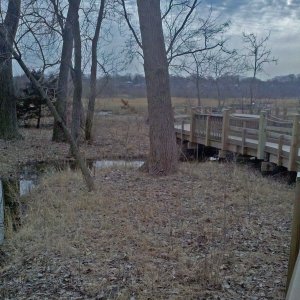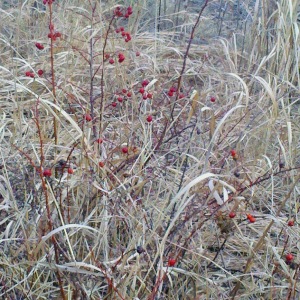Winter exits, but marsh and meadow await spring’s entrance
By Len Maniace
Snow and ice are gone from the marshes and meadows of Alley Pond Park in Queens, but winter’s left its mark. Last year’s tall reeds are laid flat by repeated snows; the fall’s brilliant leaves have aged into muted shades of tan. What’s more, winter weather has not relented for my visit to the park last Wednesday morning.
The wind blows cold off Little Neck Bay, keeping most newly emerged animal life hunkered down. The red-wing blackbirds’ cry of konk-la-ree, heard occasionally since their recent arrival from the south, is absent.
“The males come back first and start singing to stake out their territory. The females come a little later,” says Aline Euler, curriculum and grant developer at the nearby Alley Pond Environmental Center, who serves as our tour guide.
My mission for the next few months, to chart the changing seasons, is just beginning. I chose this location because it’s a mix of land and water, fresh and salt, that twice a day is flooded and drained by tides. It’s a place shaped by the actions of nature and humans.
Until recently about half the 18-acre marshland lay buried under tons of rubble from the construction of nearby highways decades ago. New York City restored nine acres here in 2012 as part of a larger project to prevent untreated sewage from flushing into Little Neck Bay during storms
This particular marshland tells several important stories: that nature is resilient, what was destroyed can be revived if attention is paid. And it tells the story of marshlands around the world: they are nurseries for aquatic life; important habitats for nearby land species, and our planet’s most productive ecosystem.
If that’s not human-centric enough for you consider this: marshlands soak up storms and floods like a sponge, forming protective barriers for inland settlements. With rising sea levels threatening our city, many believe more wetland restoration will be needed to protect New York from future floods.
As we walk from the environmental center, a former furniture store on Northern Boulevard, we pass 4-inch tufts of daffodils planted years ago as part of a September 11th remembrance. They are the surest sign of spring we see this day.
We walk along an elevated boardwalk that crosses meadow, pond and marshland and pass a patch of wild roses, most likely Rosa rugosa, whose bare branches cling tight to red rose hips. We spot a second sign of spring, the grass-like leaves of wild onions, Allium canadense. The plants are edible, but please don’t harvest them here. After flowering, small bulblets will form on the onion leaf tips by late spring.
We stroll a little further and see a pair of mallards, the glossy-green headed male and mottled-brown female. They float in a pond protected by cattails and the downed trunk of a huge tree. Mallards are considered cool-weather visitors to New York, returning to Canada by summer, but these adaptable birds often remain here year round.
Out at the end of the boardwalk, we see it’s high tide. The wind whips the water into white caps. Stands of Spartina alterniflora, which can reach five feet tall, are horizontal from the weight of winter snow. Also known as salt marsh cordgrass, it’s tenaciously rooted, allowing it to standup to storm-driven waves, while providing food and shelter to aquatic critters and migratory birds.
Still standing on the other side of the creek are waves of Phragmites australis. If good looks were all that mattered, the 10-12 foot tall grasses with fluffy seed heads would be a marshland star. Instead they are vilified as pushy invaders that crowd out Spartina and other native species which provide a far better wildlife habitat.
Finally, in the distance we see a tiny white spot against the blue of the creek. A snowy egret, Euler speculates. Neither of us have binoculars to confirm that, but it’s not an unreasonable guess. Snowy egrets, Egretta thula, are among the migratory birds arriving now in New York City. Next time we’ll bring our binoculars.
We decide to escape the wind and retrace our steps. We spot a few tiny green sprouts on land and in a small pond, but all are too small for us to identify. Not too far away we see the flame-red branches of the red osier dogwood, or Cornus stolonifera, a native shrub that’s also sold in garden stores.
We’re soon on higher ground and spot a subtle but undisputed sign of the season: clumps of multi-stemmed trees with red buds at eye level. On higher branches, buds are bursting into silvery white. They soon will turn into the furry catkins from which Salix discolor gets its common name, the pussy willow. This trip is over, but we will return soon to witness nature’s progress.

